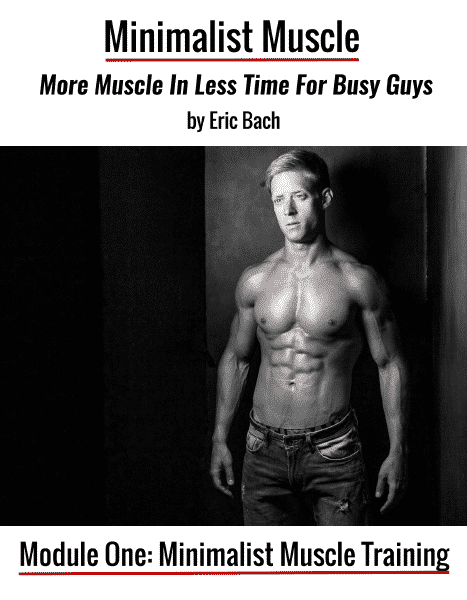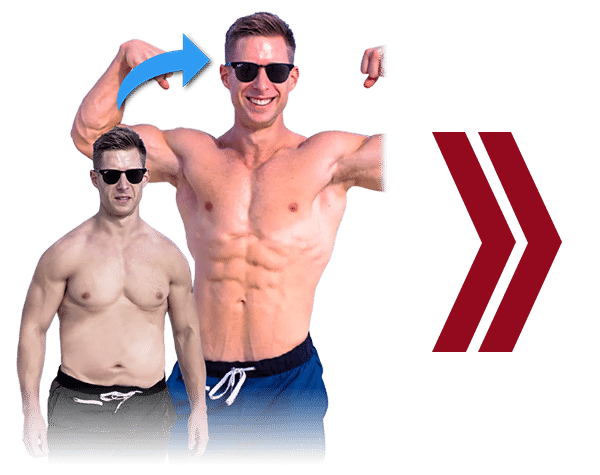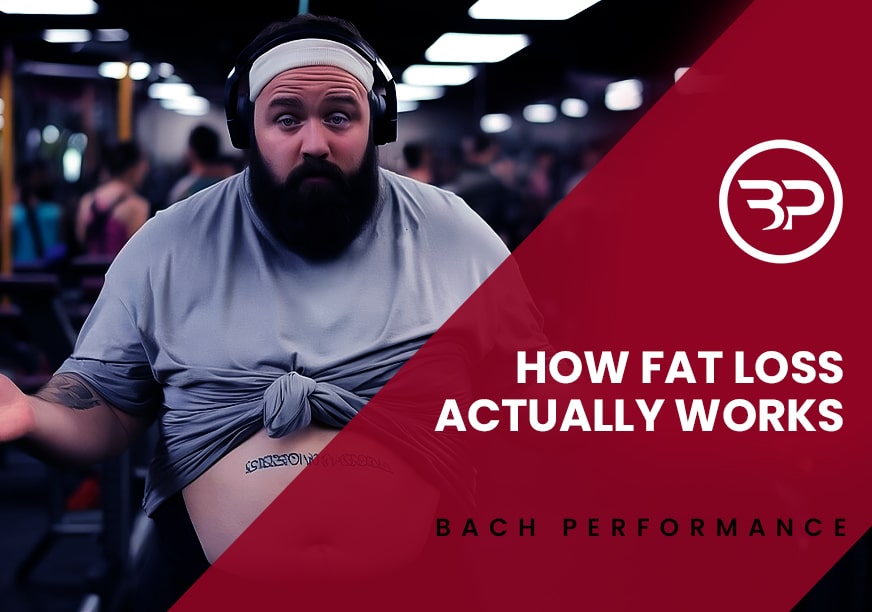How Much Cardio Should Hardgainers Do?
November 3, 2016
How Much Cardio Should Hardgainers do? Twice per week seems to be the magic number. In fact, cardio is an essential component of the Minimalist Muscle course.
I hopped on a Skype call with David a few weeks back on a Monday night.
At 5’10” and about 145 pounds, David was far from jacked, and he was very open about it.
“No matter what I do, I can’t gain size. When I lift heavy, I get stronger, but then I feel fat. But when I jog on the treadmill after each workout, I get skinnier.” Even when the scale starts to move, all the extra food I’m eating just adds to this muffin top,” he said while grabbing the bulge over his hips.
“I’m not sure what to do, Eric. How Much Cardio Should I do?”
While I appreciate his self-deprecating humor, he was only half-joking, and it pained me to see it.
I’ve been there too:
I’ve done moderate steady-state cardio, kept volume super-low and only trained twice per week, and even skipped conditioning completely. Conversely, I’ve tried to train twice per day every damn day. For a plethora of reasons, neither worked.
But every time I completely took cardio out of the equation, I ended up pudgy, unathletic, and out of shape rather than lean and muscular.
Working your ass off to earn even a smidgen of muscle, yet find that you’re getting soft and out of shape is enough for most guys to immediately flip their diet, and go back to shred-mode. And this is the exact yo-yo programming that keeps most folks in a vicious cycle of bulking and cutting, yet no discernible change in their body, performance, or confidence.
Don’t fall for the belief that getting your heart rate up will immediately shift your energy balance and cause you to stay a catabolic scrawny mess.
Chances are, you’re not the genetically gifted skinny dude who can get away with eating like a gluttonous slob and only gain muscle. More than likely, you and I are similar: We need some cardio to minimize fat gain and improve our cardiovascular health while building muscle.
With the methods below, you’ll improve your substrate utilization, meaning you’ll use fats, carbs, and protein for energy, recovery, and basic bodily functions to build muscle, rather than fat.
You’ll get more athletic.
You’ll stay healthy, instead of getting fat, bloated, and unhealthy like most other people currently bulking up.
And most of all, you’ll stay confident, knowing that if you stay the course you’ll get jacked, not fat during your bulk.
Health Comes First
You hit the gym. You build muscle. Then, despite your hard work you can’t make it up the stairs without wheezing like a smoker stopping halfway up.
Before we can specialize in training, whether it’s for aesthetic or performance purposes, we must be able to move without pain and maintain good general health.
That means if you can’t make it up the stairs without wheezing and flailing for a hand rail you have no business “bulk
ing.” In the case of cardiovascular conditioning, you need a functional baseline for health just as you need a foundation base of strength to build muscle. Without diving too far down the rabbit hole, here are a few benefits to incorporating cardio into your routine:
Improved Capillary Density and Venous Return
The more muscle you have, the more potential there is for waste products after muscular contractions. By performing cardio on a regular basis, you’ll build a support network to filter out waste products. In the context of building muscle, think about the feeling your legs have after a high-rep squats.
Pretty heavy, acidic, and shitty, right?
By improving your capillary density and ability to dispel waste products you’re able to flush the legs and get back under the bar for more training. And more training with mechanical tension, metabolic stress, and triggered protein synthesis means more gains. Therefore, a better base of cardiovascular conditioning provides you with….
Better Exercise Recovery.
Even better the mere addition of cardio into your training will help you burn glucose and fatty acids for fuel. With consistent training, your body gets more effective at burning stored fuel. In other words, consistent cardiovascular training improves energy substrate use so you burn out outside the gym, and burn stored fuel in the form of carbohydrates and fatty acids during training.
Yes, lifting needs to be your focus. But don’t fall prey to the irrational fear of losing your #gains.
What should Hardgainers do for Cardio?
In addition to three to five lifting sessions each week, you should do some form of cardio twice per week. These are your best options.
1. Jumping Rope
The jump rope is an awesome tool for hard gainers for three reasons:
Jumping rope is low Impact
Jumping rope is low impact, meaning there is little joint stress on your knees, hips, and ankles despite a high number of foot contacts. When you’re gaining weight, your joints and tissues need time to adjust to your new bodyweight. Jumping rope each day conditions the tissues of your legs to handle a heavier bodyweight.
Instead of jogging or sprinting, start (and keep) jumping rope to reduce joint stress while training at a relatively high intensity.
Jumping Rope is Self-Limiting
Jumping rope is a self-limiting exercise: to jump rope without failing you must stay in an aligned, joint stacked position while moving. This reinforces “stiffness” and a strong core that transfers force from head to toe.
This forces your trunk to stay engaged and resilient under the load of movement, a very important job if you want to stay healthy and athletic. Instead of overstriding in a sprint and popping a hamstring, you might whack your calf or stub a toe, then restart your exercise. Basically, jumping rope makes it nearly impossible to get injured compared to higher-impact options like sprinting.
Jumping Rope Keeps Your Athleticism
We’ve all seen the dudes who gain 10-15 pounds, yet all of a sudden lack any coordination or athleticism. Frankly, it’s embarrassing. You should be strong and capable. The jump-rope fixes that: By working on foot speed, timing, and coordination, you’ll preserve your athleticism even when focusing on maximum muscle growth.
Try this: Start with 3-5 minutes of jumping rope before training sessions. After two weeks, add an additional 5-minute jump-rope session after training. One month in, continue jumping rope in your warm-up but have two separate 10-15 minute conditioning sessions with the jump rope. Beyond athleticism and conditioning, you’ll see nice improvements in your calf development. Giggity.
2) Low Volume Sprints
Sprinting is an excellent form of exercise. Beyond boosting athleticism and keeping you in shape, the high-speed muscular contractions can yield similar anabolic responses to heavy weight lifting.
But, most dudes can’t line up and start sprinting around the track after a few years off. In this case, I recommend you sprint before, or on a separate day from your weight lifting.
Why Sprinting before?
While lifting needs to be your focus when building muscle, sprinting before lifting (and after a warm-up of course) will lower your risk of injury. Since sprints are a high-speed, high-impact exercise, they do strain the muscles quite a bit. Moreover, if you haven’t done them in months or years, it’s best to attack them while you’re fresh and technique stays solid before you lift.
Beyond minimizing injury risk, low-volume sprints before lifting may spark improvements in your lifting. The key is
neural recovery. Due to large and rapid muscular contractions, sprinting can potentiate your nervous system, helping you recruit more muscle fibers for your lifts.
This comes with risk vs reward trade-off. Sprinting done before training should be enough to spark the nervous system, yet low enough in volume and intensity to not fatigue the body and hinder lifting ability.
Try this: Perform low volume, short distance sprints before training rather than long-duration sprints when you’re already gassed and fatigued. Two days per week perform five sets of 10-20 yards is a great start. Then, take 5 minutes of complete rest before lifting to give your CNS a break as to not hinder performance.
This way, you’ll condition the body to high velocity, high impact movement without excess stress and training volume to interfere with your gains.
After two weeks? You should be relatively acclimated to sprinting. At this point, move sprints from before your training to after or as a separate workout. Focus on longer distances of 20-60 meters, consider a slight hill to decrease the chance of hamstring tweaks and recover on the walk back. Go for 10-20 minutes twice per week. Don’t overcomplicate it–get out, run, recovery, and repeat for time.
But If you’ve been sprinting….
With good technique and a solid base, then opt to condition after lifting. If you smashed legs, keep efforts at about 85% or use a hill or incline to prevent overstriding and hamstring issues.
Start with running two days per week on a treadmill or hill. After a warm-up and some speed drills, sprint for 10 minutes with 10-second sprints and 50-second rests, increasing sprint time by one second and decreasing sprint rest by one second each week until you build up to 15-second sprints.
- Week 1: Sprint 10 seconds, rest 50
- Week 2: Sprint 11 seconds, rest 49
- Week 3: Sprint 12 seconds, rest 48
- Week 4: Sprint 13 seconds, rest 47
- Week 5: Sprint 14 seconds, rest 46
- Week 6: Sprint 15 seconds, rest 45
Remember, all of these should be ended at the 10-minute mark. Increase your speed before jacking up the incline to preserve technique. After 10 minutes, hit a brisk walk for 10-15 minutes to cool down.
3. Optional: Dumbbell Complexes and Finishers
Conditioning complexes combine a series of movement patterns performed in series without rest, such as a squat, press, row, and RDL before starting the second set.
Your goal is to move as fast as technically possible through the lifts with lightweight and a full range of motion. Range of motion and lightweight are important because your goal is to activate as much of the body as possible, yet not crush your recoverability or conflict with the main strength work.
Ideally, use complexes and some form of a finisher for 10-15 minutes after your lift. Here are a few pointers:
Get creative: Use kettlebells, bodyweight movements, weighted carries, sleds, and battle ropes and keep moving until the timer expires.
Avoid Technical Failure: At no point should your technique deteriorate to the point you risk injury. That means to be conservative with your exercise selection and the amount of weight used.
Persevere: Complexes and finishers are a beautiful thing. Your heart should be racing. They should scare the poop (yes, poop) out of you. Transforming your body requires sacrifice, and sacrifice is only made by those willing to get uncomfortable and push through.
Try This:
| Exercise | Sets | Reps | Rest | |
| A | Hang Clean | 3 | 6 | 0 |
| B | Deadlift | 3 | 12 | 0 |
| C | Military Press | 3 | 12 | 0 |
| D | Front Squat | 3 | 12 | 60-90 sec. |
TsGet after it once per week and get beyond your comfort zone. After the complex, hop on a spin bike or other form of cardio for 10-15 minutes to cool down. These short, high-intensity killers help you stay lean through exercise post oxygen consumption (EPOC). Your heart rate stays jacked up for a greater cardiovascular benefit to keep you leaner while your building muscle.
What about walking?
Incline walking? Go for it. Two times per week for 20 minutes with your heart rate between 120-150 BPM is fine for most people. Still, I urge you to move beyond walking as cardio.
Walking is something you should be doing every day. Overall, you should we be walking each day. Most smartphones have an activity tracker; I have my clients aim for 7,000+ steps per day regardless of their goal or job. Get up and keep moving–walking is a basic human activity and will boost cardiovascular health markers, improve recovery, and by all means keep you healthy. Use cardio as a last-ditch option and find ways to incorporate more walking into your day.
You can Do It
Back to David’s Original Question:
“Should Hardgainers Do Cardio?”
Yes, Hardgainers need cardio and conditioning, even if you’re looking to add mass.
Hypertrophy training is no reason to get fat and out-of-shape—it’s a cop-out for poor planning and the result of fear.
Walk every day and include two conditioning workouts to add the finishing touches to your training. I promise you, if you’re eating enough and lifting hard, cardio will only improve your gains in the gym.
Are YOU Tired of Muscle-Building Programs that Just Don’t Work?
Join the Minimalist Muscle Movement today. It’s a state-of-the-art weight-lifting and nutritional blueprint for “skinny” guys who want to pack on muscle without living in the gym. On sale here for a limited time. 









[…] a specific block of time with one goal that builds up to the next training block. This could be a muscle building phase followed by a pure strength phase and finished with a power phase for […]